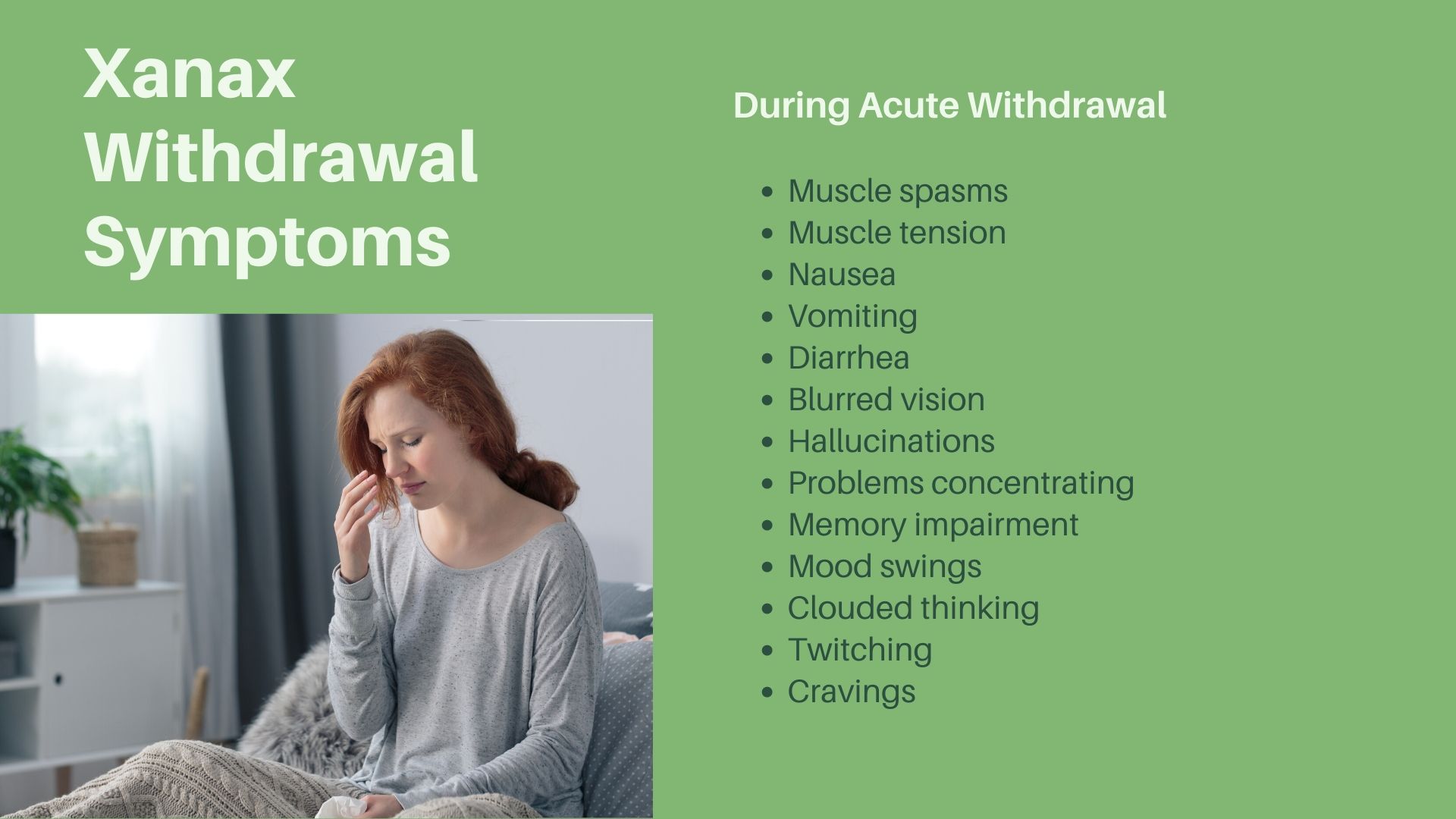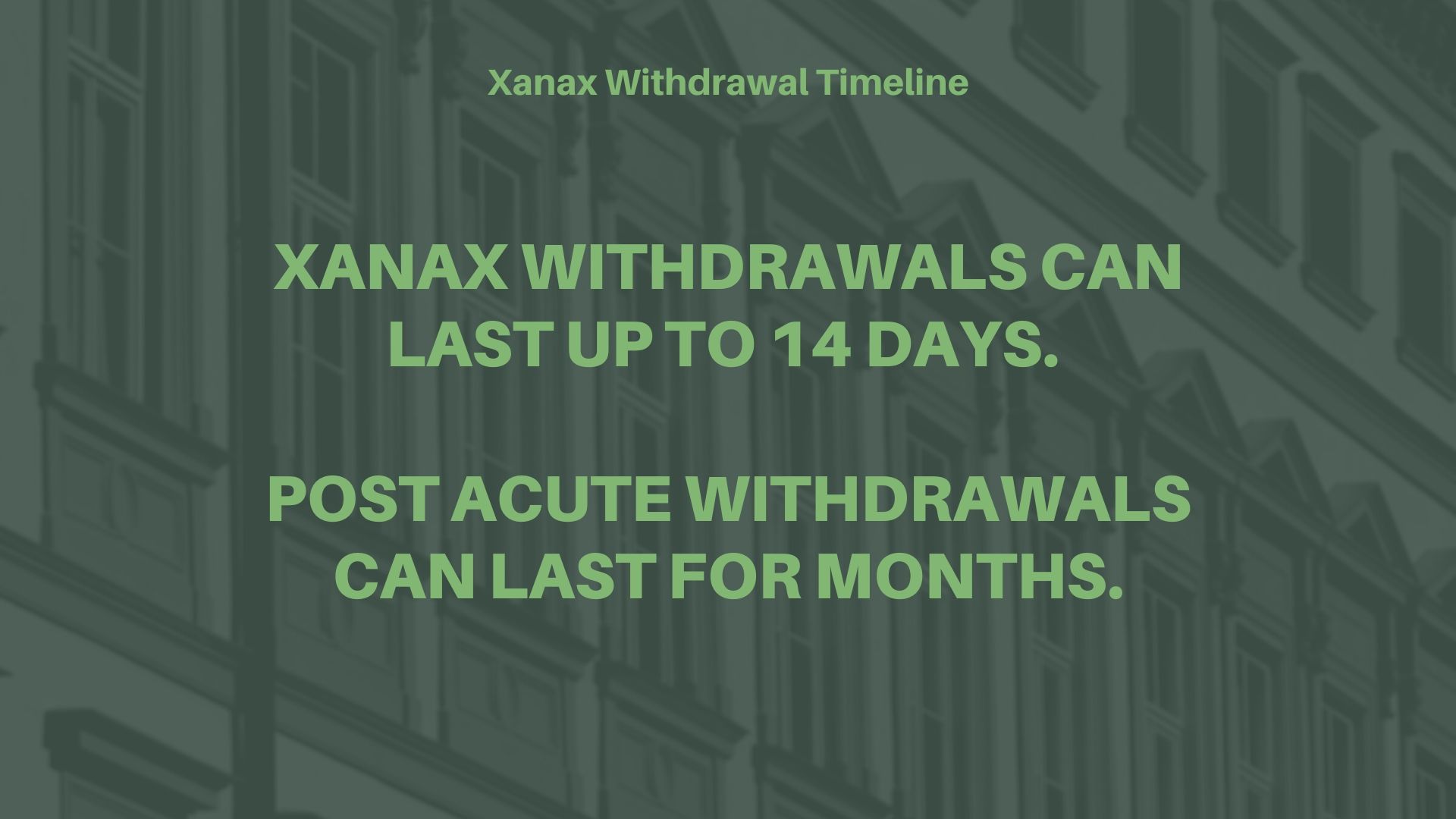Benzodiazepines like Xanax are some of the most commonly prescribed medications in the United States. They are used in the treatment of anxiety disorders (e.g. panic disorder, obsessive-compulsive disorder, social anxiety disorder) and sometimes to treat narcolepsy and other sleep-related disorders. Today, more than 40 million American adults have a clinical anxiety disorder, hence why Xanax and other benzodiazepines are so widely prescribed. In fact, the rapid increase of benzodiazepine prescriptions has most experts believing that the country is on the brink of a benzodiazepine epidemic. As the already well-established opioid epidemic continues, more and more people are including benzodiazepines like Xanax into their use, increasing their risk for overdose.
How Long Does Xanax Withdrawal Take?
Xanax, like most other benzodiazepines, is extremely easy to become addicted to, which is why so many people struggle to end their use once and for all. The very thought of no longer using is frightening enough, never mind the potential distress they can experience once they stop. Therefore, when the time comes for a person to stop abusing Xanax, the most important thing they can do is get into the care of professionals who can guide them through the imminent challenges that this type of withdrawal can produce. Unlike withdrawing from most other mind-altering substances, withdrawing from Xanax can be highly complex and even life-threatening.
Xanax withdrawal occurs in three phases. The length and severity of symptoms during each one of these stages is reflected in the specifics of the person’s Xanax use. These phases include the following:

Early withdrawal
Xanax is a short-acting benzodiazepine, so when someone who is addicted to Xanax suddenly stops abusing it, withdrawal symptoms can quickly commence. In fact, withdrawal symptoms can begin within as little as six hours after use stops. Within those early hours, a person can experience anxiety, panic, and insomnia, which are known as “rebound symptoms.” That is because when abusing Xanax, these symptoms are usually masked by the properties of the drug itself (hence why it is used to treat anxiety and sleep disorders). If withdrawing in a professional setting, a person can be slowly tapered off of Xanax to prevent these rebound symptoms from becoming severe. Early withdrawal usually only lasts for a short period of time, as most withdrawing from Xanax experience this phase for about a day or so.
Acute withdrawal
Acute withdrawal from Xanax occurs within the first few days after ending use and can last anywhere from two weeks to a few months. This stage in the withdrawal process can be extremely distressing and is usually when relapse occurs if a person is not withdrawing in the care of professionals. That is because the symptoms that develop during this time can be debilitating and last for long periods of time. While every recovering Xanax user is different, some of the most common symptoms experienced across the board during acute withdrawal include the following:
- Muscle spasms
- Muscle tension
- Nausea
- Vomiting
- Diarrhea
- Blurred vision
- Hallucinations
- Problems concentrating
- Memory impairment
- Mood swings
- Clouded thinking
- Twitching
- Cravings
During acute withdrawal, suicidal thoughts/behaviors and seizures can occur, both of which are extremely dangerous and can be life-threatening. Being in the care of professionals can help mitigate the severity of all of these symptoms, but be life-saving for those who experience seizures and suicidal tendencies, as both medical and psychiatric care can be provided.
Protracted withdrawal
While most people recovering from Xanax addiction will go through both early withdrawal and acute withdrawal, only about 10% of those withdrawing from this benzodiazepine will experience protracted withdrawal. This stage of withdrawal can last months to years after a person stops abusing Xanax and can include symptoms such as:
- Tingling in the arms and legs
- Muscle twitches
- Cognitive deficits
- Mood swings
- Insomnia
- Anxiety
These symptoms usually last for such a long period of time because Xanax has impacted the way in which the brain and other systems in the body are able to function. These effects do not disappear when use ends, as Xanax addiction can leave long-term, permanent damage. Usually, these symptoms persist because of the damage caused by excessive Xanax abuse, which include:
- Changes in chemicals in the brain, such as serotonin, noradrenaline, norepinephrine, and dopamine
- Changes in the GABA receptors in the brain
- Long-term retention of Xanax in the body’s tissues
- Physical structural changes in the brain
- Tissue damage in the brain
- Alterations in immune system
Protracted withdrawal, while it can span years, can be made easier to manage with the help of pharmaceutical interventions and therapeutic care.

Gauging the Severity of Xanax Withdrawal
Everyone is unique in their addiction, as several personal factors influence how severe their Xanax abuse becomes and, consequently, how difficult recovery might be. The intensity of a person’s Xanax withdrawal is typically reflective of their relationship with this benzodiazepine, as well as other individual factors. Consider the following:
Length of use
Long-term Xanax abuse can lead to structural changes in the brain and changes within the systems in the body, creating several obstacles for a user to overcome during withdrawal. These changes can increase symptoms of anxiety and depression, as well as make it more difficult to focus, all of which are risk factors for continued substance abuse. Therefore, when someone has been abusing Xanax for a long period of time, getting into professional treatment is necessary to help prevent from frequent relapse.
Amount used
The more Xanax a person abuses, the more difficult it becomes for the body and the mind to adjust when use stops. Withdrawal symptoms ranging from headaches to seizures are often more severe in those who have abused large amounts of Xanax, which can intensify and prolong detox.
Mental illness
Nearly half of those who have a substance use disorder like Xanax addiction also have a co-occurring mental illness. In some cases, the mental illness has been occurring even before the Xanax abuse began, while in other cases, the abuse came first. Either way, any time mental illness is present during withdrawal, it can make the period of time spent getting off of Xanax much longer and more complicated. This is especially true for those who had a mental illness prior to developing a Xanax addiction, as their symptoms are more likely to present themselves once they stop abusing this drug. These symptoms, plus the symptoms of the disease of addiction will need to be simultaneously treated in order for a person to achieve a successful recovery.
Family history
Xanax withdrawal historically takes longer in those with a family history of addiction and/or mental illness. Not only is there the potential for a person to have genetic components that increase their challenge of getting sober, but they have likely been negatively influenced by their environment at some point in their lives. Family history like this can increase symptoms related to depression and anxiety disorders, both of which have the potential to make withdrawal more severe.
When any one of these factors are playing a role in a person’s withdrawal, the entire process can take longer, never mind if more than one is occurring. Addiction is a highly complex disease and even detoxing from a drug like Xanax can provide its own set of challenges that elongate the process. Getting professional treatment is one of the best ways to help shorten the length of withdrawal so that true recovery can begin.

Xanax Withdrawal at a Treatment Center — Why Is It Important?
Substance use disorders like Xanax addiction are best treated in a professional setting where there are mental health and medical specialists who can assist in a safe, effective recovery. This is because, above all else, ending Xanax abuse cold turkey can be fatal. Sudden cessation of this drug can cause seizures and suicidal behaviors, both of which can lead to death. Ensuring that symptoms are properly managed and treated is vital during withdrawal, which is why beginning the process of detox in a treatment center is critical.
Outside of having severe symptoms monitored and treated, going through Xanax withdrawal at a treatment center is important for the following reasons:
- Minimizing all other symptoms — Xanax withdrawal causes several symptoms that are not life-threatening but are upsetting and sometimes even debilitating. Symptoms such as headaches, muscle aches, nausea, and vomiting can be minimized with over-the-counter and prescription medications. Reducing the intensity of symptoms can make for an easier, shorter period of withdrawal.
- Preventing relapse — Relapsing during Xanax withdrawal is very common, as the symptoms that develop can become too hard to handle. When in a treatment center, however, relapsing isn’t possible like it would be if a person were withdrawing at home because Xanax and other substances are not able to be obtained.
- Offering continuity of care — When a person is detoxing, the best thing they can do for themselves is to continue on with therapeutic treatment once they have detoxed fully. Already being in a detox center allows for an easy transition into that type of care, as most detox centers offer treatment programs or have connections to other facilities who do.
Am I Addicted to Xanax?
It is not always easy to see if your behaviors surrounding your Xanax use are consistent with addiction, especially because the use of Xanax in people of all ages and races is very common. It is so common, in fact, that the use of it has been glamorized in movies, tv, music and social media. However, using Xanax in any other way other than what is recommended by your own personal doctor can be a sign of a much bigger problem.
If you are addicted to Xanax, you will experience several symptoms of that addiction. These include, however, are not limited to, the following:
- Continuing to abuse Xanax despite not wanting to
- Continuing to abuse Xanax even though your abuse has caused serious consequences
- Abusing Xanax in dangerous situations
- Spending a significant amount of time trying to get and use Xanax
- Needing more Xanax in order to achieve desired effects
- Experiencing withdrawal symptoms when unable to use as much as normal or when not using at all
- Abusing Xanax for longer periods of time than originally planned
- Cravings for Xanax
- Socially isolating from friends, family, and loved ones
- Struggling at work, home, and/or at school
- Having run-ins with the law
- Financial problems due to spending excessive amounts of money to support your Xanax abuse
When the abuse of a drug such as this starts getting to the point where an addiction is forming, it can be very difficult to hide from others. Therefore, you may be experiencing an addiction to Xanax if you have several people confronting you about your use.
Get Professional Help by Calling JourneyPure Right Now
If you are struggling with an addiction to Xanax, know that you do not need to keep going this way. We are here to help you overcome your challenges with your addiction so that you can live a happy, healthy life free of mind-altering substances.
Call our Xanax rehab today. We can help.
From the JourneyPure team where we get to explore a wide variety of substance abuse- and mental health-related topics. With years of experience working alongside those suffering from substance abuse and mental health issues, we bring important messages with unparalleled knowledge of addiction, mental health problems, and the issues they cause.
